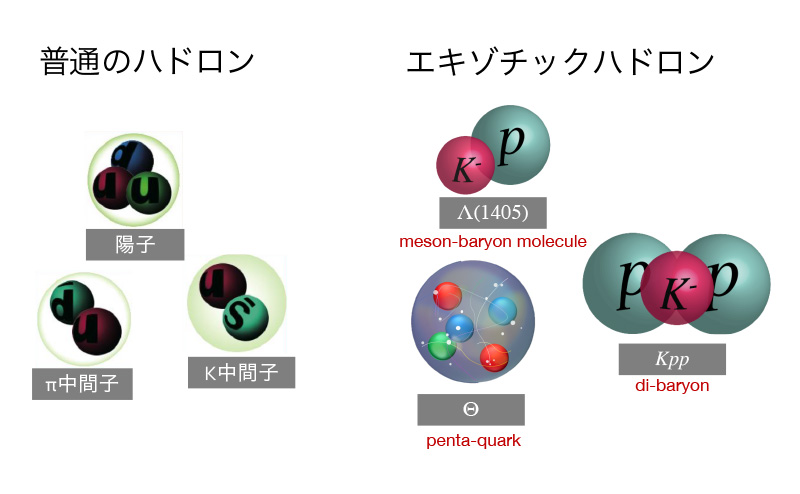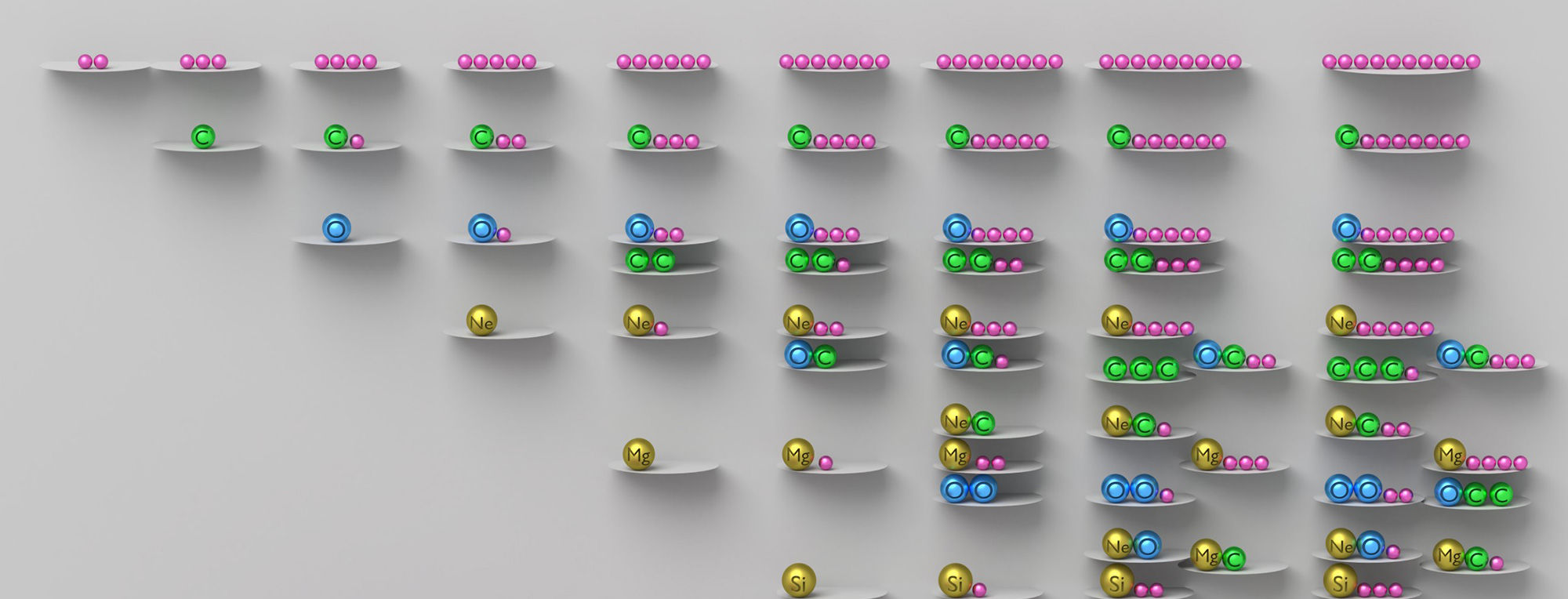Our goal is to investigate and understand the wonders of "hadrons", the systems that strong interactions interact with. First of all, let me explain about hadrons.
The relatively familiar language, such as the protons and the neutrons, are the hadron family. These hadrons are known to be extremely small, for example, a hadron is smaller than 1/10^-15 of a meter.Surprisingly, hadrons, despite their small size, have an internal structure. They contain quarks, which are famous as elementary particles, and gluons, which are responsible for strong interactions. The fact that they have an internal structure is important, as the combination of the components and the changes in the internal state produce a wide variety of hadrons. Did you know?
There are more than 100 different types of hadrons known to exist !! With a great deal of enthusiasm, research on hadrons has been going on for more than a century. Research on hadrons is fraught with great difficulties, such as
- They are too small.
- Many hadrons have short lifetimes, and the only way to measure them is by measuring the particles that decay.
- Many hadrons have short lifetimes, and the only way to measure them is by measuring the particles that decay.
However, through a large number of theoretical and experimental approaches, the idea that hadrons are composed of quarks has finally been accepted. In the simple quark model, hadrons can be divided into two types : baryons, which are composed of three quarks, and mesons, which consist of a quark and its antiparticle. This model claimed that hadrons, of which there are several hundred types, are actually composite particles made up of only six particles. In spite of the simplicity of the model, it explained a lot of things such as mass and reaction rates.
Nowadays, exotic hadrons are of particular interest to us researchers (see Fig. 1). They are so called because they are "exotic" hadrons that go beyond the simple quark model. For example, the tetra (penta) quark, which consists of four (five) quarks, and the meson baryon bound states belong to this category. Exotic hadrons have been theoretically predicted since the 20th century. However, at present, there are almost no experimental proofs of their existence. It is very interesting to know whether they exist or not. In addition, we believe that more detailed investigation of exotic particles may reveal the unknown side of the strong interaction (although it is still difficult to do so).
In the LEPS2 group, we are mainly studying exotic hadrons, and also various hadron physics. In 2003, the theta particles were suggested to exist in the previous LEPS experiment. Accelerator experiments were carried out all over the world to confirm the truth of this. There were many negative reports as well as positive ones.Currently, the existence of the theta particle is under debate. One of the major objectives of the LEPS2 experiment is to settle this issue. The other main themes of the LEPS2 experiment are the search for the die baryon kpp and the elucidation of the internal structure of the meson-baryon molecule state Λ(1405).
The special feature of this experimental group is the use of photons as a scalpel to open up hadrons. However, we do not actually use photons to cut hadrons open. Hadrons are generated when a beam of high energy photon (gamma rays) is irradiated on a target. The hadrons decay in an instant, and by observing the decayed particles, we can indirectly "see" the hadrons that should not be visible. Since photons have no internal structure, the mechanism of photoproduction reactions is well understood. Therefore, the use of γ-rays is considered to be an ideal technique to investigate the properties of hadrons.
On the other hand, photoproduction is difficult to occur, which is a disadvantage in experiments. Therefore, it is necessary to irradiate high intensity γ-rays stably for a long time to measure the reaction. The LEPS group has been focusing on the accelerator at SPring-8. A laser is injected into the higher-energy electrons, and the reflected photons are used as beams. By this method, we have succeeded in producing a γ-ray beam with both high energy and high intensity. In addition, this method has the advantage of achieving high polarization. By controlling the polarization of the beam, it is possible to investigate the reaction in more detail than with experiments using alternatively polarized beams. This is advantageous for unraveling complex hadronic phenomena.
The strength of the LEPS2 group lies not only in the measurement of photoproduction reactions. We have a great detector: solenoidal spectrometer. This is the detector suite that allows us to observe not only exotic hadrons, but also a wide variety of hadron physics. The solenoidal spectrometer consists of several state-of-the-art detectors inside a solenoidal magnet, allowing for highly accurate momentum measurements. With a length of 5 m and an inner diameter of 2 m, the spectrometer covers a large area and efficiently detects the generated particles. Currently, this spectrometer is nearing completion (see Fig. 2).
Now we are ready to acquire the data. The next step is to analyze the acquired data. The analysis requires a lot of manpower. Young researchers, including those in graduate school, are expected to play an important role in the advancement of hadron physics.
-

Fig. 1: Conceptual diagram of internal structure of hadrons.
Exotic hadrons are hot right now! -

Fig. 2: Solenoid spectrometer. The momentum of charged particles are reconstructed using the trajectories in the solenoid magnet.
-

Fig. 3: Searching for Θ particle is one of the main theme of LEPS2.
LEPS2 is a solenoid spectrometer to search for the Θ particle, which is a candidate for pentaquark. There is a rumor that some students nickname this spectrometer "Pazu" in a certain Ghibli film.
